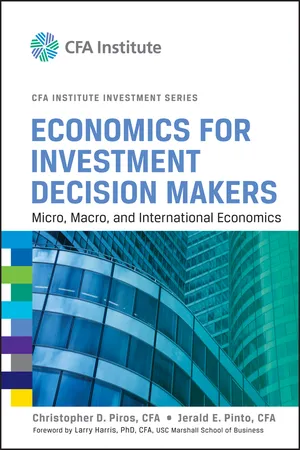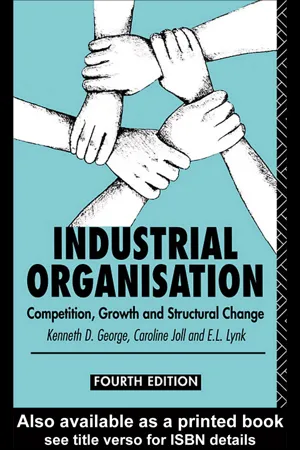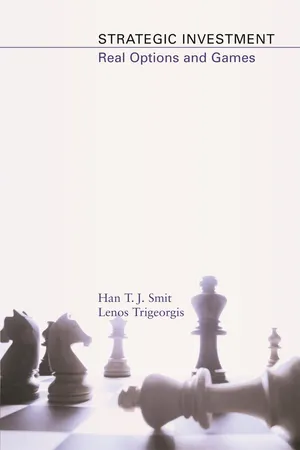Business
Stackelberg Oligopoly
Stackelberg oligopoly is a market structure in which one firm, the leader, sets its output or price first, and then the other firms, the followers, make their decisions. The leader has a strategic advantage as it can anticipate the followers' responses. This model is based on the idea of sequential decision-making and is often used to analyze competition in industries with a dominant firm.
Written by Perlego with AI-assistance
Related key terms
Related key terms
1 of 4
Related key terms
1 of 3
7 Key excerpts on "Stackelberg Oligopoly"
- eBook - ePub
Economics for Investment Decision Makers
Micro, Macro, and International Economics
- Christopher D. Piros, Jerald E. Pinto(Authors)
- 2013(Publication Date)
- Wiley(Publisher)
The Cournot equilibrium and the Nash equilibrium are examples of specific strategic games. A strategic game is any interdependent behavioral choice employed by individuals or groups that share a common goal (e.g., military units, sports teams, or business decision makers). Another prominent decision-making strategy in oligopolistic markets is the first-mover advantage in the Stackelberg model, named after the economist who first conceptualized the strategy. 10 The important difference between the Cournot model and the Stackelberg model is that Cournot assumes that in a duopoly market, decision making is simultaneous, while Stackelberg assumes that decisions are made sequentially. In the Stackelberg model, the leader firm chooses its output first and then the follower firm chooses after observing the leader’s output. It can be shown that the leader firm has a distinct advantage, being a first mover. 11 In the Stackelberg game, the leader can aggressively overproduce to force the follower to scale back its production or even punish or eliminate the weaker opponent. This approach is sometimes referred to as a “top dog” strategy. 12 The leader earns more than in Cournot’s simultaneous game, while the follower earns less. Many other strategic games are possible in oligopoly markets. The important conclusion is that the optimal strategy of the firm depends on what its adversary does. The price and marginal revenue the firm receives for its product depend on both its decisions and its adversary’s decisions. 5.2. Supply Analysis in Oligopoly Markets As in monopolistic competition, the oligopolist does not have a well-defined supply function. That is, there is no way to determine the oligopolist’s optimal levels of output and price independent of demand conditions and competitor’s strategies. However, the oligopolist still has a cost function that determines the optimal level of supply - eBook - ePub
Industrial Organization
Competition, Growth and Structural Change
- Kenneth George, Caroline Joll, E L Lynk(Authors)
- 2005(Publication Date)
- Routledge(Publisher)
However, if, following this argument, both firms wish to act as leaders and move first, then no equilibrium will initially be reached since each firm chooses its profit-maximising output on the assumption that the other firm will ‘follow’, i.e. take up the indicated point on its reaction function, and if the other firm has also decided to behave as a leader this expectation will not be fulfilled. If both firms decide to behave as followers, then the Cournot solution will be reached. The existence of the Stackelberg equilibrium as a stable solution to an oligopoly model which is different from the Cournot solution, therefore, depends on one firm choosing to be the leader and one the follower. This raises the question of why this should happen. This can’t be answered within the simplifying assumption that the two firms are identical, because if one firm would gain from being leader then so would the other and no equilibrium will be reached. However, if firm A is quicker than B to grasp the advantage of acting as a leader, then B will recognise that, once A has moved to its profit-maximising point on R B, B’s own profits will be better if it decides to act as follower than if it also tried to be a leader, since in this case their joint output will be high, profits will be low and they will be pushed towards the competitive solution. An advantage which will enable one firm to act as leader might be conferred by superior size. However the Stackelberg model leads to a different result from price leadership models in which an industry consists of one big (dominant) firm and a competitive fringe of smaller firms (see Chapter 6). Another situation in which one firm has an advantage which will enable it to act as leader is where a market contains a single incumbent firm who is faced with the strategic choice of whether to allow another firm to enter the market, or to prevent entry - No longer available |Learn more
- Bonnie Nguyen, Andrew Wait(Authors)
- 2015(Publication Date)
- Routledge(Publisher)
15 OligopolyDOI: 10.4324/9781315690339-1515.1 Introduction
We now turn to the case of oligopoly, a market that contains a small number of firms. Because there are only a handful of key producers in the market, the decisions of each firm have ramifications for not only itself but also for each of its competitors. For example, if Dell adjusts its price for one of its laptops, this will generally have an impact on its competitors, such as HP. Similarly, if a department store decides to advertise, it might be able to increase its customer base at the expense of other firms. Given the impact oligopolists have on one another, a firm’s strategic choice – be it price, its output, whether it introduces a new product and so on – will typically depend on what other firms in the market are doing. For instance, a brewer might consider dropping its price following a price reduction from a major beer manufacturer in the same market. In the soft-drink market, following the introduction of a new energy drink by Pepsi, Coca-Cola may choose to respond with its own alternative. In a similar way, if Samsung introduces a new phone handset, Apple will consider what it should do regarding a new version of its iPhone. A pharmaceutical company will consider what new drugs its rivals are trying to develop (and those that they already have patents for) when considering its own research and development programme. This strategic interaction between firms is a key feature of oligopoly; moreover, this sort of strategic interaction is absent in other market structures we previously studied (perfect competition, monopoly and monopolistic competition).We model strategic interaction in oligopoly using game theory. We have previously discussed the core concepts and tools of game theory in Chapter 3 . In this chapter, our goal is to illustrate how game theory tools can be applied in the context of an oligopoly. In doing so, we will highlight a few key examples of how firms in an oligopoly strategically interact with each other, but our examples will by no means be an exhaustive demonstration of what game theory can tell us in this context. We urge you to familiarize yourself with the contents of Chapter 3 - eBook - ePub
Microeconomic Theory second edition
Concepts and Connections
- Michael Wetzstein(Author)
- 2013(Publication Date)
- Routledge(Publisher)
5. The Cournot model assumes that oligopolistic firms do not realize the interdependence of their decisions with their competitor's decisions. In contrast, the Stackelberg model assumes that one firm is a leader and takes the likely response of a competitor, the follower, into consideration.6. The Cournot and Stackelberg models assume that firms determine their output, and, based on the total output supplied, the market determines the price. Alternatively, the Bertrand model assumes the reverse behavior, where firms determine their price and the market then determines quantity sold.7. A major cartel influencing world oil prices is the OPEC cartel. This cartel is not backed by any legal provisions, so it has a history of instability in its efforts to boost the price of crude oil.8. (Appendix) Product differentiation in terms of location is called spatial differentiation. Even if the products are identical, a firm's location can differentiate its product from its competitors.9. (Appendix) The necessary and sufficient conditions for the perfectly competitive equilibrium location for two firms are when the two firms locate at the same place and have no incentive to change locations.10. (Appendix) Within the United States, certain industries are prohibited from colluding, and treble damages may be assessed for illegal pricing practices. However, assessing these damages may not yield the efficiency results that the US Department of Justice enforcing the antitrust acts would yield.10. (Appendix) - eBook - ePub
- J. Bridge, J. C. Dodds(Authors)
- 2018(Publication Date)
- Routledge(Publisher)
6 Market Structure6-1 Introduction
In our economic analysis of the firm we have stressed the importance of both internal and external resource allocation. Traditional economic theory, we have argued, focused on the firm as part of a market system and therefore was concerned more with external resource allocation whereas newer contributions have examined decision making and resource allocation within the firm per se. However, decisions whether strategic or operating, cannot be taken without some reference to the environment in which firms operate, in particular with regard to the state of competition, and this therefore leads us into a discussion of the relationship between market structure and business behaviour. This discussion begins with a clarification of the concepts and definitions involved in the study of markets in Section 6-2 ; followed by a classification of market structures comprising perfect competition, monopoly, monopolistic competition and oligopoly in Section 6-3 . We spend the majority of our time here with oligopoly because this is the dominant form of market structure in manufacturing industry. We note that ‘mutual interdependence’ of decisions is an important consideration and that competition often takes the form of non-price methods particularly with the use of advertising.The existence of interdependence in oligopolistic markets and the resultant difficulty of developing determinate models has resulted in a failure to develop a general theory of oligopoly. We look at the issue of collusion, both open and tacit, in Section 6-4 , followed by an examination of the kinked demand curve model (Section 6-5 ), and the sales revenue maximisation model (Section 6-6 ). The latter is an interesting model in that it is an attempt to systematise managerial discretion in objectives as well as to account for some of the features noted in oligopolistic industries, particularly the use of non-price competition. This model does have some drawbacks although it is a useful teaching aid in that it links well with the other models of managerial discretion as well as other models of oligopolistic behaviour notably the kinked demand curve. We then introduce Game Theory in Section 6-7 - eBook - ePub
Strategic Investment
Real Options and Games
- Han T. J. Smit, Lenos Trigeorgis(Authors)
- 2012(Publication Date)
- Princeton University Press(Publisher)
Maximizing V i (P i, R j (P i)) over P i, given R j (P i), gives a Stackelberg leader price (for q i = q j = 0): Note that the above Stackelberg leader price may exceed the Nash equilibrium price of equation 6.A.19. Substituting this into the follower’s reaction function from equation 6.A.18 would give the Stackelberg follower’s price. In case the leader invests first (I, D) and demand is low such that it becomes uneconomical for the follower to operate profitably, the leader can improve by earning monopoly profits. 1 Kulatilaka and Perotti (1998) make the point that the first mover gets a larger market share. An increase in uncertainty increases the first mover’s market share and the relative value of early investment. 2 Grenadier and Weiss (1997) model optimal investment strategies when a firm is confronted with a sequence of technological innovations, while Williams (1993) and Grenadier (1996) model exercise strategies in real estate development. McGahan (1993a) models the effect of incomplete information about demand on preemption. 3 The symbols C, S, M, A, D at the bottom of figure 6.2 refer to the different market structure games described herein (and summarized in table 6.1). As noted, the state payoff values at the end of the second stage are the outcomes of different market structure games depending on the state of demand (θ), each firm’s actions (invest, do not invest/defer), and their timing (simultaneous or lagged, at t = 1 or 2). 4 In contrarian quantity competition, an aggressive firm that invests early, acting as a Stackelberg leader, can acquire a larger share of the market. Under reciprocating price competition, a Stackelberg price leader would choose a price on the competitor’s reaction function that maximizes its profit value - eBook - ePub
Microeconomics
A Global Text
- Judy Whitehead(Author)
- 2014(Publication Date)
- Routledge(Publisher)
DD ). The difference is that in this case, the firm is able to see both curves, unlike under the model of Monopolistic Competition.12.6 The Stackleberg Sophisticated Duopolist Model
The Stackleberg model of oligopoly (duopoly), appearing in the 1950s, is considered to represent an advance over the Cournot and Bertrand/Edgeworth models. The model follows those of Cournot and Bertrand/Edgeworth with two variants, one using the ‘Cournot assumption’ and the other using the ‘Bertrand/Edgeworth assumption’. Stackleberg’s work removes some of the concerns with the earlier models, principally the following:- It obviates the need for the simplification of costless production in the older models by introducing iso-profit and reaction curves. This development is based on Stackleberg’s contention that the previous models’ assumption of costless production is unrealistic and could be relaxed without impairing the validity of the model.
- It introduces the ‘sophisticated’ firm which can anticipate its rivals reactions and incorporate them into their own profit function to replace the myopic and naïve behaviour of firms in the older models.
12.6.1 Iso-profit and reaction curves using the Cournot assumption
The reaction curves approach of Stackleberg is based on the use of the iso-profit curves and takes into account production costs by tracing the reaction to profits. The reaction process is therefore no longer based on revenue only as in the Cournot models.
Index pages curate the most relevant extracts from our library of academic textbooks. They’ve been created using an in-house natural language model (NLM), each adding context and meaning to key research topics.
Explore more topic indexes
Explore more topic indexes
1 of 6
Explore more topic indexes
1 of 4






